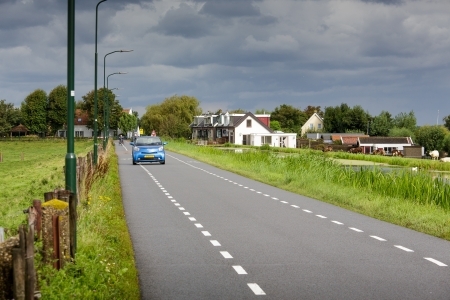Access roads are located in residential areas and provide access to homes, businesses, schools, shops, etc. This means that the residential function is more important than the traffic function and that all types of traffic mix: pedestrians, cyclists, cars, and trucks. Because of the great difference in mass between the road users and the fact that pedestrians and cyclists are largely unprotected, motorised traffic should drive at low speeds.

Figure 5. Urban access road (Photo: Paul Voorham).
Urban areas
Access roads in urban areas have a 30 km/h speed limit. Supporting this limit usually requires physical speed inhibitors. For more information, see SWOV fact sheet 30 km/h zones. In addition to 30km/h access roads there are home zones. Home zones have a 15 km/h speed limit and pedestrians can use the entire width of the street for walking and playing. Home zones can not only be found in residential areas, but also in shopping areas and in the vicinity of train stations.
Rural areas
The speed limit on rural access roads is 60 km/h. From a Sustainable Safety perspective, 40km/h would be preferable, but in determining the requirements for the various road categories, 60km/h was chosen. This is a compromise between requirements for traffic flow on the one hand and requirements for safety on the other hand. In special situations, for example when the access road is a parallel road with only destination traffic, at an important (bicycle) crossing or on access roads in quiet areas, a speed limit of 30 km/h may be set [5].
Generally, physical speed inhibitors on access roads are only used at intersections (raised intersections). Road sections are often fitted with edge strips (a discontinuous line at some distance from the roadsides, sometimes asphalted in red), whereby a driving strip for motor vehicles is created in the middle of the carriageway. This leads to a visual narrowing of the road which results in lower speeds. In case of sufficient width, the edge strips on either side of the driving strip can be used by cyclists. For more information, see the archived SWOV fact sheet Edge strips on rural access roads.

Figure 6. Rural access road (Photo: Paul Voorham).
Intersections
- Intersections between access roads are at grade and without any designated priorities (priority for traffic from the right).
- Intersections between an access road and a distributor road are also at grade. Traffic on the distributor road has priority. The connection from the access road preferably has a so-called exit structure, but traffic signs (RVV signs B1 to B7) are also possible.

